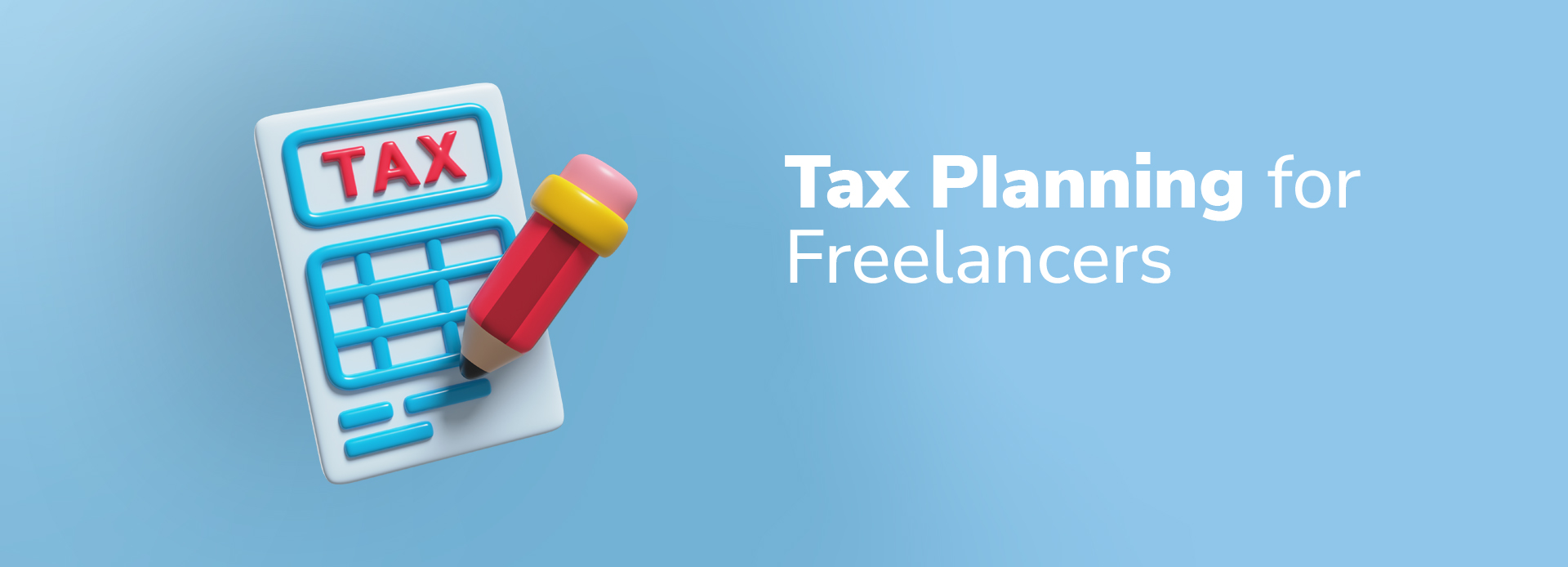
Tax Planning For Freelancers and Self-Employed Individuals
21 March 2024 | By INDIE
As a freelancer or self-employed individual, you have the freedom to work on your terms and schedule. However, it also means you are solely responsible for managing your finances, including taxes.
Tax planning may be complex, but it is crucial for financial well-being. By understanding the basics of tax planning, you can maximise your deductions, minimise your tax liability, and keep more of your hard-earned money.
This article discusses some practical tips and strategies to help you with tax planning as a freelancer or self-employed individual.
Income Tax Slabs for Freelancers and Self-Employed Individuals
Income Slab |
Old Tax Regime |
New tax Regime (until 31st March 2023) |
New Tax Regime (From 1st April 2023) |
₹0 - ₹2,50,000 |
- |
- |
- |
₹2,50,000 - ₹3,00,000 |
5% |
5% |
- |
₹3,00,000 - ₹5,00,000 |
5% |
5% |
5% |
₹5,00,000 - ₹6,00,000 |
20% |
10% |
5% |
₹6,00,000 - ₹7,50,000 |
20% |
10% |
10% |
₹7,50,000 - ₹9,00,000 |
20% |
15% |
10% |
₹9,00,000 - ₹10,00,000 |
20% |
15% |
15% |
₹10,00,000 - ₹12,00,000 |
30% |
20% |
15% |
₹12,00,000 - ₹12,50,000 |
30% |
20% |
20% |
₹12,50,000 - ₹15,00,000 |
30% |
25% |
20% |
>₹15,00,000 |
30% |
30% |
30% |
Key Points to Consider While Tax Planning
Know your Tax Obligations
As a freelancer or self-employed, you must understand your tax obligations to prepare your taxes efficiently. If your annual income is more than ₹2.5 lakh, you must file an income tax return (ITR) annually.
Along with that, you also need to pay taxes on your business income. Your business income is determined by calculating your net profit after deducting all the permissible expenditures. You need to pay taxes on this income as well. This will help you avoid any penalties or legal issues in the future.
Track Your Expenses
Keeping proper records is essential for accurate tax preparation. Whether you work for yourself or as a freelancer, keep track of all your business expenses by collecting receipts and invoices. This will help you claim deductions and reduce your tax liability.
Additionally, having separate bank accounts for your personal and business transactions is a great way to keep things organised.
If you work for yourself and pay income tax, you can save money by claiming some of your work-related expenses. These expenses might include things like:
● Rent
● Office supplies
● Telephone and internet bills
● Repairs
● Travel and hospitality expenses related to your business
● Professional fees
By claiming these expenses, you can reduce your taxable income and, as a result, pay less tax.
Claim Your Deductions
Section 80 C Deductions
As a self-employed individual, you can save up to ₹46,800 in taxes every year by investing up to ₹1.5 lakh in eligible options under Section 80C of the Income Tax Act. These options include:
Equity-Linked Savings Scheme (ELSS) |
Unit Linked Insurance Plan (ULIP) |
Public Provident Fund (PPF) |
National Pension Scheme (NPS) |
Life Insurance Premiums |
Sukanya Samriddhi Account |
National Savings Certificate (NSC) |
Five-Year Tax-Saving Bank Fixed Deposits |
Employee Provident Fund (EPF) Contributions |
Infrastructure Bonds |
NABARD Rural Bonds |
Senior Citizen Savings Scheme |
Five-Year Post Office Time Deposit Scheme |
Tuition Fees Paid for Up To 2 Children |
Registration Charges & Stamp Duty for a Home/Property |
Principal Repayments of Home Loans |
Planning expenses carefully and keeping sufficient proof to claim deduction benefits is essential.
Reduce Tax Liability with the Right Tax Method
Choosing the right tax method can also help reduce your tax liability. An accountant or tax advisor can help you decide between ITR-4 and 4S. ITR-4 is for individuals or HUFs whose primary source of income is proprietary business or profession, with turnover/gross receipts over ₹1 crore. On the other hand, ITR-4S is for individuals whose business earnings are below ₹1 crore.
Presumptive Tax Scheme
You can also opt for the presumptive tax scheme if your income is under ₹50 lakhs per year and your annual turnover is within ₹2 crore. Under this scheme, you can claim expenses up to 50% of your total income; the remaining 50% is taxed after adding interest income. You don't need to provide separate proof of expense or maintain accounting records.
Example:
Gaurav is a practising lawyer with an annual income of ₹50,00,000 in the current financial year. He spends ₹10,00,000 as actual operational expenses to run his practice. The tax liability for Rakesh for FY 2023-24 is as follows:
Particulars |
Tax Liability with Presumptive Taxation |
Tax Liability without Presumptive Taxation |
Income |
₹50,00,000 |
₹50,00,000 |
Expenses |
₹25,00,000 (50% of income is eligible for deduction) |
₹10,00,000 |
Taxable income |
₹25,00,000 |
₹40,00,000 |
Tax liability |
₹4,87,000 (excluding cess) |
₹9,37,000 (excluding cess) |
Therefore Gaurav would save ₹4,50,000 from his tax outgo if he follows presumptive taxation.
Tax Deducted at Source for Freelancers
Tax Deducted at Source (TDS) is a tax deduction that freelancers can claim when filing their Income Tax Return (ITR) form. This deduction ensures that they pay their due tax on their income and applies to salaried individuals and freelancers.
Freelancers may be subject to a 10% TDS deduction before payment from their clients, which can increase to 20% if they don't provide their Permanent Account Number (PAN). To view all TDS/TCS deducted from income, freelancers can use Form 26 AS, linked to their PAN number. This form allows a consolidated view of all TDS and taxes deducted.
Pay Your Tax in Advance
If you work as a freelancer or self-employed individual, and your tax due exceeds ₹10,000 in a year, you need to pay advance tax. This means that you will have to pay your tax in instalments throughout the year, and the final payment is due by March 15 of the following year.
By doing this, you can avoid any interest and penalties for late tax payments. So, make sure to pay your advance tax on time to avoid any additional charges.
Choose the Right Business Model
Tax planning is crucial for freelancers and self-employed individuals. They can operate as a sole proprietorship, partnership, private limited company, or limited liability partnership (LLP). Each structure has unique tax implications, so choosing one that suits your needs and objectives is crucial.
- A sole proprietorship is the simplest and most affordable option, but it doesn't offer limited liability protection.
- A private limited company offers limited liability protection but is more complex and expensive to set up and operate.
Therefore, it's essential to choose a business structure that aligns with your goals and offers the best tax benefits, saves money and protects your business in the long run.
Conclusion
Tax planning is important for both freelancers and self-employed individuals. It helps to reduce the tax burden by identifying and utilising all correct deductions and credits. It is vital to keep accurate records, keep track of expenses and income, and consult with a tax professional if needed.
By implementing tax planning strategies and staying on top of tax obligations, freelancers and self-employed individuals can save money and avoid any potential penalties.
Remember, good tax planning is not only about saving money but also about staying compliant with the law. For more such interesting reads, check out the INDIE blog!





